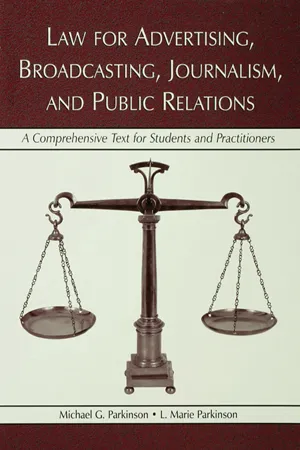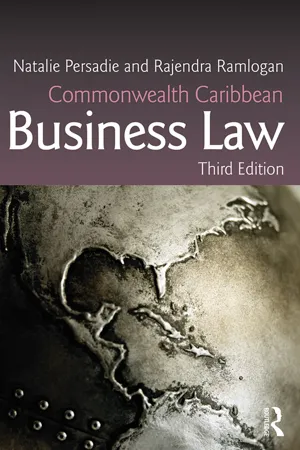Law
US Legal System
The US legal system is a complex framework of federal and state laws, regulations, and court decisions that govern the country. It is based on the principles of federalism, separation of powers, and the protection of individual rights. The system includes both civil and criminal law, with a hierarchical structure of courts to interpret and apply the law.
Written by Perlego with AI-assistance
8 Key excerpts on "US Legal System"
Learn about this page
Index pages curate the most relevant extracts from our library of academic textbooks. They’ve been created using an in-house natural language model (NLM), each adding context and meaning to key research topics.
- eBook - ePub
Law for Advertising, Broadcasting, Journalism, and Public Relations
Law for Advertising, Broadcasting, Journalism, and Public Relations
- Michael G. Parkinson, L. Marie Parkinson(Authors)
- 2013(Publication Date)
- Routledge(Publisher)
1 Introduction to the Legal SystemOverview Background of Government and Court Structures Sources of Law in the United States Other Legal Systems Types of Courts Jurisdiction and Venue Legal Hierarchy and Authorities Rules for Justiciability OverviewCertainly, all those who have framed written constitutions contemplate them as forming the fundamental and paramount law of the nation, and consequently, the theory of every such government must be, that an act of the legislature, repugnant to the constitution, is void.—Chief Justice John Marshall1This chapter begins with an explanation of the legal system and sources of law in the United States. This information is essential to any understanding of the laws that impact the practices of advertising, broadcasting, journalism, and public relations. It also helps the reader interpret and apply the laws described later.We begin with a brief comparison of governmental systems and a description of sources of law. We then describe legal systems and the types of courts that function both at the federal level and in the individual states. Included in the description of the courts are an introduction to the ideas of jurisdiction and legal authority. We con clude by describing the different types of opinions rendered by the U.S. Supreme Court and the rules of justiciability the court uses to avoid making unnecessary decisions and to avoid interfering with the states and other branches of the U.S. government.Background of Government and Court StructuresLaws are the principles that structure the relationships between government and the gov erned and among the people within a society. To understand law, one must first have a feel for the government itself. Therefore, we begin with a cursory explanation of the structure of government so you will have a foundation for a later explanation of our legal system.Systems of GovernmentThere are three types of governments: the unitary, the confederal, and the federal. The differences among the three are based on how power is distributed and on the placement of sovereignty. - eBook - ePub
American Civilization
An Introduction
- David Mauk, Alf Tomas Tønnessen, John Oakland(Authors)
- 2021(Publication Date)
- Routledge(Publisher)
Chapter 9 The legal system- Legal history
- The sources of US law
- The court system
- Federal and state court proceedings
- The legal profession
- Crime and punishment
- Attitudes to the legal system
- Exercises
- Further reading
- Websites
In her speech accepting the nomination as a Supreme Court justice in September 2020, judge Amy Coney Barrett proclaimed: “A judge must apply the law as written.” In saying so, she invoked the view of her mentor – the late Justice Antonin Scalia, who died in 2016 – and advocated the idea of “original intent.” Barrett and Scalia believe that judges should interpret what the founders meant in 1787 rather than interpret law in light of the development of society in the last 200 years. Liberals, by contrast, often argue that it is important to take the development of society into consideration and read the Constitution as a flexible document. This was a rationale behind the famous Brown v. Board of Education decision in 1954, which declared segregation of public schools unconstitutional.This chapter examines the historical development of the US Legal System, describes the court apparatus and federal and state court proceedings, considers the role of the legal profession, comments upon crime and punishment and concludes with attitudes to the legal system. For practical purposes, this system consists of judges and lawyers who serve in independent state and federal courts, which are concerned with two main types of law (civil law and criminal law). The individual cases dealt with by the courts and other institutions are accordingly classified as either civil or criminal.Civil law involves claims for compensation (often financial) by individuals (or groups) who have suffered loss or damage through the acts of others. Domestic actions (divorce, children, and custody), automobile accidents, personal injury cases, libel and corporate matters are the main civil actions. Civil law has a service role and tries to secure social harmony by settling disputes between individuals or organizations. This is achieved preferably by settlement through litigation and negotiation. If no settlement is agreed, the case goes to a full trial. - eBook - ePub
Cybercrime and Information Technology
Theory and Practice: The Computer Network Infostructure and Computer Security, Cybersecurity Laws, Internet of Things (IoT), and Mobile Devices
- Alex Alexandrou(Author)
- 2021(Publication Date)
- CRC Press(Publisher)
Common Law, where precedents and authority are set by previous court rulings. Case law is created when judges follow the judicial decisions made by court rulings in a prior case. Case law is used by lower courts and judges to identify which law applies to a dispute, to establish criminal procedure, or to create a criminal defense for a crime. In 49 states, laws are largely derived from English Common Law, but in Louisiana, laws are based on the French Civil Code.In the United States, laws are ratified, explained, and enforced by the federal, state, and local levels of government. The hierarchy of the laws of the United States is:- U.S. Constitution
- Laws enacted by U.S Congress
- Agency regulations by federal agencies
- State Constitutions
- Laws ratified by a State Legislation
- Rules and regulations by State Agencies
- Ordinances (city or county)
- Rules and regulations by Local or City agencies.
3.2.1 The Courts System
The Judicial system is classified by a hierarchical structure at both state and federal levels. federal and state governments, along with U.S. territories, have separate court systems. For the most part, each has District courts, Appeals courts, and Supreme courts, in addition to various courts at local levels, for example traffic court.Federal jurisdiction consists of U.S. District Courts and U.S. Courts of Appeals or Circuit Courts, which are the first level of appeal, and finally the U.S. Supreme Court, the final level of appeal. Although Article III of the U.S. Constitution requires the establishment of District Courts, these were established pursuant to the Judiciary Act of 1789. U.S. District Courts handle civil and criminal trials within the federal court system. These 94 district or trial courts are organized in 12 regional circuits.The U.S Appeals Court consists of 13 appellate courts. These courts oversee civil and criminal cases inside clear geographic or subject areas. Federal Courts function differently than State courts.Federal courts hear only cases authorized by the U.S. Constitution or federal statutes. The federal government can prosecute criminal offenses only in federal courts, and the States must bring criminal prosecutions only in State courts. In addition, according to the Fifth Amendment to the U.S. Constitution, the legal term Double Jeopardy - eBook - ePub
- Stephen J. Spurr(Author)
- 2019(Publication Date)
- Routledge(Publisher)
3 Introduction to the legal systemThis chapter introduces some legal terminology that is used throughout the text, and some basic features of the legal system. At the same time we will show how economic analysis can be used to explain these features, which might otherwise seem completely arbitrary.We first consider the different stages and different possible outcomes of a lawsuit (a civil action). We examine the doctrine of precedent, how a lawsuit may create a precedent, and the body of all precedents, which is known as the common law. We also consider an economic analysis of the doctrine of precedent developed by Landes and Posner.There are substantial differences in the burden of proof applicable to different legal controversies. We consider an economic explanation for these differences, to illustrate how economics is used to analyze procedural issues.Finally, we consider the design of the U.S. Constitution. The founders believed that, to provide a legal foundation for the nation’s economic growth and development, the Constitution had to depart from the scheme of the Articles of Confederation, by transferring vast governmental powers from the states to the federal government. At the same time, the founders thought it imperative to ensure that this transfer of power would not lead to an undue concentration, or (in economic terms) a monopoly, of power in the central government. Accordingly, many provisions of the Constitution were designed to prevent that outcome. We will analyze the sections of the Constitution that are intended to thwart the acquisition of a monopoly of governmental power. We also examine the division of powers between the federal government and the states, including their respective courts.Although the specific institutional features we describe are those of the U.S. legal system, the issues that arise apply to any legal system.Litigation and the court systemA lawsuit is called an “action” by lawyers. An action is viable only if it is based on a valid legal claim, or “cause of action.” We can, and should, divide all actions between civil and criminal cases, since the substantive and procedural rules applicable to them are completely different. In a civil action a plaintiff files a lawsuit against one or more defendants; in a criminal case the accused party is the defendant, and the plaintiff is the government. - eBook - ePub
- Michael Flynn, Kirk Buffington, Richard Pennington(Authors)
- 2020(Publication Date)
- Routledge(Publisher)
Contracts operate within a broad context of law and regulations. This chapter focuses on the essential principles and structure of the United States legal system. The discussion introduces statutes broadly applicable to commercial practices in the market economy, the Sherman and Clayton Anti-Trust Acts, as well as their impact on the protection of market competition. The chapter includes two other statutory schemes broadly applicable to both public procurement and other government and commercial operations: open records statutes and intellectual property rights. The chapter concludes with an overview of the United States judicial structure and suggested guidelines for performing legal research.
The American legal system is founded upon English tradition with a singularly American twist. The American legal system looks to statutory law, administrative law, and common law for its guidance.The Foundation: Sources and Types of LawStatutory Law
Statutory law includes the Constitution of the United States in addition to the constitutions of the various states and the charters of local government entities. The United States Constitution is the primary source of law in our country. Among other things, it establishes the relationship between the federal government and the states. The Constitution authorizes the U.S. Congress to enact laws within the powers granted by the Constitution. The authority not specifically granted to Congress or other parts of the federal government are then reserved for the states. As the predominant source of law, public entity legislation, administrative rules, and contract provisions can be invalidated if they violate constitutional protections. For example, the United States Supreme Court has invalidated government contract provisions establishing submission of offers and participation preferences based on the ethnic status of company owners where not supported by adequate factual evidence of past discrimination.Statutory law also includes the legislative enactments by the U.S. Congress, the various states’ legislative bodies, and the legislative actions of local government entities. The primary source of law and authority for public procurement professionals is legislatively enacted statutes and ordinances. This legislation not only grants contracting authority to a government official or entity, but also may set out the specific policies and procedures for purchasing goods and services. For example, most state statutes contain a specific section concerning public works projects that include the requirements for the construction of public buildings and facilities. - eBook - ePub
School Law for K-12 Educators
Concepts and Cases
- Frank D. Aquila(Author)
- 2007(Publication Date)
- SAGE Publications, Inc(Publisher)
Introduction to the Legal System and Legal ResearchOVERVIEW OF THE LEGAL SYSTEM
The heart of the body of knowledge commonly identified as education or school law is statutory and case law. The material included in this book, whether case briefs, outlines, or textbook/treatise reference information, provides a summary of the most important aspects of the law regarding education.Statutory law is made up of criminal and civil laws, or statutes . Statutes are enacted by a governmental body authorized to pass such laws. For example, Congress enacts federal statutes; state legislatures enact state statutes; and local elected bodies, such as city councils, enact municipal ordinances . Case law refers to the body of written decisions that have been rendered at the conclusion of lawsuits, or cases, that come before various courts.Two types of courts with which you will need to be familiar are trial courts and appellate courts. A trial court renders two types of decisions: decisions based on law and decisions with respect to facts. Trial court decisions made on the basis of law are usually made by a judge; a jury makes findings of fact. An appellate court generally reviews the decisions of trial courts in order to determine whether proper procedures were followed and whether the correct law was applied. Usually, only appellate courts render decisions that, when published, become case law.Another way to categorize courts is by the nature of the disputes that particular courts consider. In civil law, legal disputes arising between two or more parties usually occur in a particular state or are based on state law principles. Such suits are properly filed in state courts. On the other hand, matters that arise in or involve more than one state (diversity jurisdiction ) or that specifically involve the federal government, federal laws, or federal constitutional issues are filed in federal courts .In the state court system, a case is first heard by a trial court. An appeal “of right” to the state appellate level is available, while the state supreme court has discretion to either grant or deny further review on appeal. This discretionary review is called certiorari , or sometimes, “granting cert.” Figure I.1 - eBook - ePub
- Landsberg C, S Graham, Landsberg C, S Graham(Authors)
- 2017(Publication Date)
- Van Schaik Publishers(Publisher)
694The legal system and the judiciary
Roxan Venter1The following key issues are dealt with in this chapter:- The nature of law and of the judicial function
- The origins and nature of the South African legal system
- How law is classified and the sources and contents of South African law
- The South African court system
- The independence of the courts
- The judicial process and procedures that are followed in civil and criminal cases
- The role and influence of the judiciary in the political system
4.1 Introduction
Every state has a legal system comprising the rules of law that apply in that state. Everybody, from the different organs of state to the individual, is engaged daily in the application of those rules of law to their relationships. Every state also has a judicial branch of government that resolves, on an authoritative basis, disputes that arise between members of society, by the application of the appropriate rules of law. Within the trias politica, the judiciary, as the third branch of government, therefore has the key function of ensuring that everybody – the people as well as all organs of state – abides by the law.4.2 The nature of the law
The notion of an independent judiciary that applies the law impartially and without fear, favour or prejudice is generally accepted as a cornerstone of democracy. But what is law, and what is the nature of the judicial function? It has been said that law consists of rules that dictate how we must or must not act as members of society (Rautenbach & Malherbe, 2009: 2). As there are many other rules that govern our conduct, such as the rules laid down by parents for their children, associations for their members, and universities for their students, the question to be answered is: when can rules be described as law?There is one determining factor, which distinguishes rules of law from other rules that apply in society: only rules of law can be enforced by the State (Rautenbach & Malherbe, 2009: 4). There are different reasons for this. Firstly, 70 - eBook - ePub
- Natalie Persadie, Rajendra Ramlogan(Authors)
- 2015(Publication Date)
- Routledge-Cavendish(Publisher)
Chapter 1Introduction to Legal Systems
Reproduced with the permission of Stu’s ViewsThe rule of law
Law is a social phenomenon. It has grown into an essential principle of social organisation in Western civilisations as a result of the historicity of those societies.1 Law functions as the formal machinery for creating and maintaining social order, as seen in the Western world. All societies possess some degree of order which allows for sustained social interaction within a period of time. The form of order which exists depends on the particular society and the perceived needs of that society. Political, historical and moral characteristics of a society also assist in shaping that form of order. According to Sinha, law is a composite of three components: rules of law (mental), attitudes (psychological) and external aspects (behaviour). It is these three components which shape law in any given society; however, the question begs itself, how does law maintain social order? Law prescribes what acceptable social conduct for any given society is and punishes deviant behaviour which results in conflict or disorder. There are established institutions and procedures through which the law operates in civil and criminal issues to return a society to its status quo of social normalcy.The constitutional and administrative law of the United Kingdom has long respected a number of values, many of which are encapsulated in the concept of the rule of law: checks against arbitrary power; democracy through universal suffrage and regular elections; representative and accountable government; individual freedom; fair procedures; and judicial independence.2 The intricately woven interrelationship between government and the law is reflected in the concepts postulated by the rule of law. The notion itself is fluid and lends itself to a wide range of interpretations. Despite the inability to propose a concrete definition for the concept, it is accepted that central to the general idea of the rule of law is the specific proposition that it involves the rule of law as opposed to the rule of people to control the exercise of arbitrary power. It can be said that it is usually intended to imply that the powers exercised by politicians and officials must be based on authority conferred by law and that the law should conform to certain minimum standards of justice, both procedural and substantive.3







